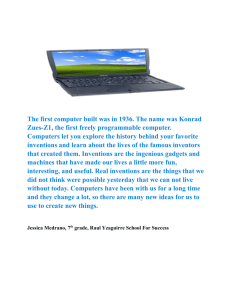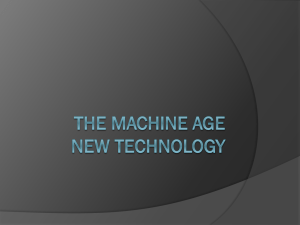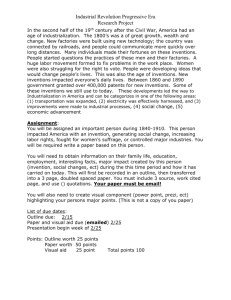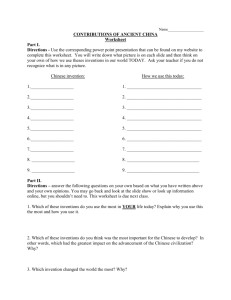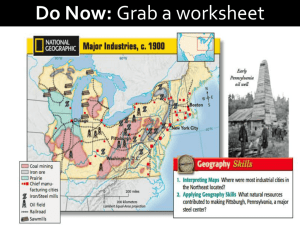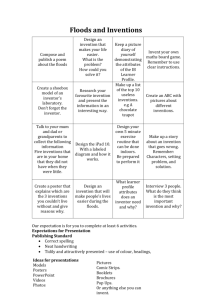Week 2 February 1-5
advertisement
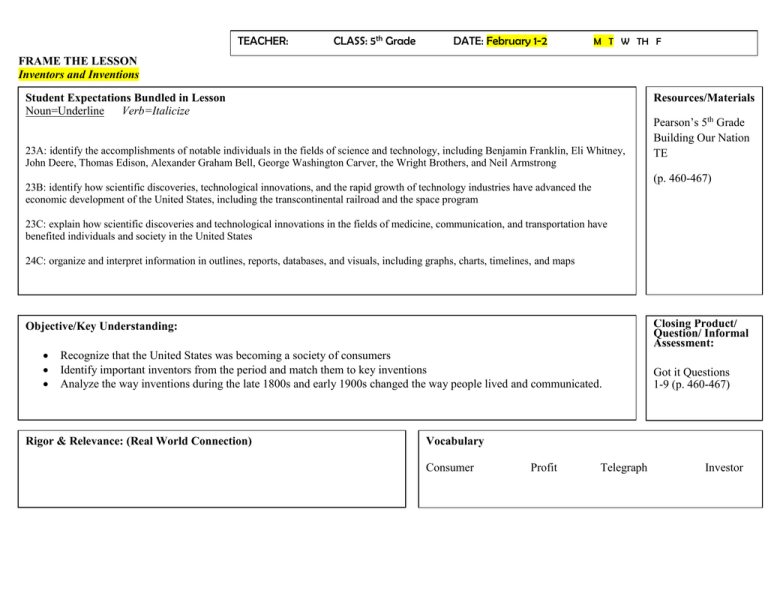
TEACHER: CLASS: 5th Grade DATE: February 1-2 M T W TH F FRAME THE LESSON Inventors and Inventions Resources/Materials Student Expectations Bundled in Lesson Noun=Underline Verb=Italicize 23A: identify the accomplishments of notable individuals in the fields of science and technology, including Benjamin Franklin, Eli Whitney, John Deere, Thomas Edison, Alexander Graham Bell, George Washington Carver, the Wright Brothers, and Neil Armstrong Pearson’s 5th Grade Building Our Nation TE (p. 460-467) 23B: identify how scientific discoveries, technological innovations, and the rapid growth of technology industries have advanced the economic development of the United States, including the transcontinental railroad and the space program 23C: explain how scientific discoveries and technological innovations in the fields of medicine, communication, and transportation have benefited individuals and society in the United States 24C: organize and interpret information in outlines, reports, databases, and visuals, including graphs, charts, timelines, and maps Closing Product/ Question/ Informal Assessment: Objective/Key Understanding: Recognize that the United States was becoming a society of consumers Identify important inventors from the period and match them to key inventions Analyze the way inventions during the late 1800s and early 1900s changed the way people lived and communicated. Rigor & Relevance: (Real World Connection) Got it Questions 1-9 (p. 460-467) Vocabulary Consumer Profit Telegraph Investor Stop and Check for Understanding- High Level Questions New Ways to Communicate (p. 461) During which years did the greatest growth in daily calls take place? What is profit? Why would an investor give money to an investor? What are some of the benefits of the telephone? Edison’s Bright Idea (p. 462) What is a phonograph? What was the problem with Edison’s light bulb? What are some of the inventions Thomas Edison and his associate developed? The Impact of Electricity (p. 462) Where did the first power station in the United States open? How did Tesla’s actions lead to more people having access to electricity? How do you think electricity changed people’s everyday lives? How did the invention of electricity affect technology that came after it? New Ways to Travel (p. 464) What does the image on page 464 show? Why did Americans prefer the electric streetcar over the horse car? Who is responsible for placing the first gasoline engine inside a car? Why did people call the first automobiles “horseless carriages”? Why does the graph on page 464 have a jagged notch between 4 and 9? Airplanes and Flight (p. 465) Why did the Wright brothers experiment with kites? Why do you think the Wright brothers didn’t give up when their glider did not work well? How do you think the wind tunnel helped the Wright brothers? On what day did the Wright brothers successfully fly their invention? How long did the first airplane flight last? The Impact of Inventions (p.466-467) What effects did the telephone have on the economy? What was done at a telephone exchange? What does the phrase “shrink distances” on the chart title mean? Have student use the chart on page 466 to make a generalization about communication and travel inventions. What questions might you ask passengers on one of the first flights? Which invention or technology do you think made the greatest change in how people lived in the United States in the early 1900s? Introduce the Key Idea & Vocabulary (p. 460) Read to the class the Key Idea: “I will know that Americans developed new inventions that changed life in the United States and around the world.” Tell students in this lesson they will be learning about this quote and what it means to American History. Go online to access the Lesson Introduction and discuss the Big Question and lesson objective (p. 438). Students are to complete the Using the Words to Know Worksheet before reading the lesson. Remind students that they will know that Americans developed new inventions that changed life in the United States and around the world. Explore New Ways to Communicate (p. 461) Edison’s bright Idea (p. 462) The Impact of Electricity (p. 462) New Ways to Travel (p. 464) Airplanes and Flight (p. 465) The Impact of Inventions (p.466-467) Remind students that they will know that Americans developed new inventions that changed life in the United States and around the world. Explain New Ways to Communicate (p. 461) In the mid-1800s, Samuel Morse had invented the telegraph. This device sent little bursts of electricity along wires. Morse developed a code based on short bursts (dots) and longer burst (dashes.) The telegraph used this code, called Morse code, to send messages quickly. Americans used the telegraph system for the first time in May 1844. Edison’s bright Idea (p. 462) Thomas Alva Edison introduced the world to a lot of new inventions. Edison set up a research laboratory in Menlo Park, New Jersey, in 1876. He worked with a team of young scientists to solve problems. His was the first research lab of its kind. In 1877, Edison invented a machine that could record sounds and play them back. It was called a phonograph. The phonograph mad Edison famous. People called him the Wizard of Menlo Park. The Impact of Electricity (p. 462) Edison had to find a way of getting electricity into homes and businesses. On September 4, 1882 he opened the first electric power station in the United States at Pearl Street in New York City. Electricity produced there traveled through wires to nearby buildings. New Ways to Travel (p. 464) In 1832, people in New York City had a new way to get around. Instead of coaches that bumped along rough streets, they could now ride in streetcars that ran on smooth, steel railroad tracks. Like a coach, a streetcar was pulled by horses, but the tracks made the ride more comfortable and faster. People called this streetcar a horse car. Riders paid about ten cents for a ride. Horse cars traveled about six to eight miles per hour. Like buses, they made regular stops. They became very popular. By the mid-1880s, more than 400 companies around the nation were carrying 188 million passengers a year over more than 6,000 mile of “street rail” track. Airplanes and Flight (p. 465) Using trains and trolleys, people were now traveling more quickly. Soon, two American inventors would take to the skies. Brothers Wilbur and Orville Wright ran a bicycle repair shop in Dayton, Ohio. But they dreamed of building a flying machine. The Impact of Inventions (p.466-467) Thousands of miles lie between the West Coast and the East Coast of the United States. So inventions that made distances easier to cross became popular quickly. As people began to talk, drive, or fly over long distances, these inventions changed lives and the economy. Telephones and other communication technologies continue to make your life easier today. Elaborate Questions from the Stop and Check for Understanding- High Level Questions are to be used here. (Please see this from above). Students will demonstrate mastery by completing the Got It Questions: (below is a sampling of the questions a teacher can use to evaluate Evaluate student mastery). Analyze the chart. Then draw a conclusion from the information presented. (p.460) Explain why telephones attracted investors. (p. 461) Examine the timeline. For each date, identify the invention and name of the inventor. (p.462) Analyze the line graph page 464. Write a conclusion you can draw about car ownership base on the information in the line graph. Use the picture and the text on page 465 to identify the accomplishments of the Wright Brothers and explain why they were successful. Write what you think would be harder to live without, a car or a telephone? Explain. (p. 467) Engage FRAME THE LESSON Predicting Consequences TEACHER: CLASS: 5th Grade DATE: February 3 M T W TH F Student Expectations Bundled in Lesson Noun=Underline Verb=Italicize Resources/Materials: Pearson’s 5th Grade Building Our Nation TE 24B: analyze information by sequencing, categorizing, identifying cause-and-effect relationships, comparing, contrasting, finding the main idea, summarizing, making generalizations and predictions, and drawing inferences and conclusions Objective/Key Understanding: Know what consequences are. Analyze information to make predictions. Analyze how text organization influences relationships among ideas. Closing Product/ Question/ Informal Assessment: Apply the Skill (p. 469) Rigor & Relevance: (Real World Connection) (p. 468-469) Stop & Check for Understanding—High Level Questions Preview the Sill (p. 468) Have students recall how early pioneers adapted to unfamiliar land, plants, and animals. Propose that new inventions may one day allow people to settle on other planets. Have students think about the consequences of settling on other planets based on what they know about how earlier people settled new land. Recall how early pioneers adapted to unfamiliar land, plants, and animals. Practice the Skill (p. 468) What might be the consequences of creating inventions for using Earth’s resources? Apply the Skill (p. 469) Read the passage on page 469. Using information from that passage, answer the following questions: Vocabulary: Vocabulary: Summarize two important facts about solar energy that you learned in this article. What is one invention that uses solar? What does it do? What do you think are some possible good consequences of using this invention? What do you think would be the consequence of using a solar collector in a place that doesn’t get much sun? Think about an invention you use every day that is important to you. Describe the consequence of having that invention taken away. Engage Explore Explain Preview the Skill (p. 468) Have students recall how early pioneers adapted to unfamiliar land, plants, and animals. Propose that new inventions may one day allow people to settle on other planets. Have students think about the consequences of settling on other planets based on what they know about how earlier people settled new land. Recall how early pioneers adapted to unfamiliar land, plants, and animals. Making Predictions (p.468) Build background knowledge on predicting consequences. Use the following ideas to differentiate instruction for students when discussing how to predict consequences. Special Needs: Explain to students that a consequence is what happens because of another action. When you look ahead to predict possible consequences, you can make a plan of action. Review the steps on page 468 for predicting consequences. Extra Support: Present students with a news story from the local community about a recent change, such as a new law. Guide students through the steps to make a list of possible consequences as a result of this change. On-Level: Have pairs of student create a two-column poster for predicting consequences. Tell them to summarize the steps on one side. On the other side, have them write a concrete example of each step. Challenge/Gifted: Have students decide on a new invention or way of doing something. Have them follow the steps for predicting consequences and then write about their results, presenting them to the class. Practice the Skill (p. 437). Ask students to read the information on page 468 to learn how to predict consequences. A consequence is what happens as a result of another event. It is what follows and is caused by an action or event. If you can predict consequences, you can better choose what action to take. Predicting consequences can help you get better results. Predicting consequence can help you better understand what you are reading. These steps can help you predict consequences: Elaborate Evaluate Think about what is happening Look for clues about what might happen next Think about what you already know about similar actions and their results or consequences. Today, new inventions using Earth’s resources are being developed. Read this article about solar energy. Then, answer the questions that follow. After students learn about predicting consequences, use the ELPS support note on page 460b to help the English Language Learners. Have students learn how to predict consequences to assist with understanding what they read. Beginning Tell students that consequences are the result of another event. Knowing how to identify potential consequences can also help them understand what they read. Read aloud the paragraphs on page 468. As you read, tell students to think about what is happening. Intermediate Read aloud the content on page 468. Tell students that as you read, they should do the following in order to predict what will happen next: Think about what is happening, look for clues about what might happen next, and think about what they already know about a similar action and their results. Advanced Have students work in pairs to predict what will happen next in the text. Students should take turns reading the text aloud. As they read, they should take notes and apply the predicting strategies that are listed on page 468. Advanced High Have students read page 468. As they read, they should take notes using the predicting strategies on page 468. When they are finished reading, they should share if the consequences they thought would occur were accurate. Have students work in groups to complete the Apply Activity. Alternatively, this activity can be assigned as homework. Apply the Skill (p. 469) Summarize two important facts about solar energy that you learned in this article. What is one invention that uses solar? What does it do? What do you think are some possible good consequences of using this invention? What do you think would be the consequence of using a solar collector in a place that doesn’t get much sun? Think about an invention you use every day that is important to you. Describe the consequence of having that invention taken away. FRAME THE LESSON The Impact of Big Business TEACHER: CLASS: 5th Grade DATE: February 4-5 M T W TH F Resources/Materials Student Expectations Bundled in Lesson Noun=Underline Verb=Italicize 7A : describe a variety of regions in the United States such as political, population, and economic regions that result from patterns of human activity Pearson’s 5th Grade Building Our Nation TE (p. 470-475) 8C: analyze the reasons for the location of cities in the United States, including capital cities, and explain their distribution, past and present 11A: describe the development of the free enterprise system in colonial America and the United States 12B: evaluate the effects of supply and demand on business, industry, and agriculture, including the plantation system, in the United States Closing Product/ Question/ Informal Assessment: Objective/Key Understanding: Explain how individuals and businesses made decisions about taking risk based upon a hope for profit. Describe how the growth of big business, such as steel, oil, and railroads, had an impact on increased urbanization. Describe the development of the free enterprise system in the United States. Evaluate the effects of supply and demand on business and industry. Rigor & Relevance: (Real World Connection) Got it Questions 1-8 (p. 470-475) Vocabulary Urbanization Free enterprise system Stock Assembly line Entrepreneur Monopoly Refinery Corporation Stop and Check for Understanding- High Level Questions Business Leaders Take Risks (p. 470-471) What qualities do you think an entrepreneur needs to have? What effect do you think affordable steelhead on the building industry? What were Andrew Carnegie’s contributions? Inventions and Businesses (p.472) What is “a share”? How were car tires made by other companies different from Harvey Firestone’s tires? How did automobiles help create jobs? How did the introduction of airplanes help the U.S. Post Office? Industry and Resources (p.473) What are natural resources? Why was oil an important natural resource during this time? What is done at a refinery? What might happen to the oil in Beaumont, Texas, once all of the oil companies begin operating there? Why do you think monopolies might be bad for consumers within a free enterprise system? Cities and Businesses (p.474) What are the costs and benefits of cities linked to important industries? What did the 1920 census show for the first time? Why did regions rely more and more on other regions? In the last paragraph the author says,”… it was an exciting time.” Is this a fact or an opinion? Why? In what year was there the biggest difference between urban and rural populations? In 1900, what was the difference in percentage of population between people living in urban and rural areas? How do you think the population will continue to change throughout the rest of the twentieth century? Engage Explore Explain Introduce the Key Idea & Vocabulary (p. 470) Read to the class the Key Idea: “I will know that the growth of big business had a great impact on life in the United States.” Tell students in this lesson they will be learning about this quote and what it means to American History. Go online to access the Lesson Introduction and discuss the Big Question and lesson objective (p. 438). Students are to complete the Using the Words to Know Worksheet before reading the lesson. Remind students that they will know that the growth of big business had a great impact on life in the United States. Business Leaders Take Risks (p. 470-471) Inventions and Businesses (p.472) Industry and Resources (p.473) Cities and Businesses (p.474) Remind students that they will know that the growth of big business had a great impact on life in the United States. Business Leaders Take Risks (p. 470-471) It was, and still is risky to start a business. But if you are successful, there are great rewards. One thing that was needed in the rapidly growing cites was steel. An entrepreneur named Andrew Carnegie was determined to supply it. An entrepreneur creates and runs a new business and takes on all the risks of the business. Inventions and Businesses (p.472) Growing cities needed bigger buildings. The strength of steel made bigger buildings possible. In 1885, the first skyscraper was built in Chicago, Illinois. Soon, tall buildings were going up everywhere. Industry and Resources (p.473) The country’s natural resources also helped the economy grow. Rich farmland produces abundant crops, and industries developed to process and package food. Forests produced wood for lumber that was used to build homes for the growing population. Iron ore from Pennsylvania and the Great Lakes region supplied the steel industry. Many cities and state capitals were established near major rivers and bodies of water. This allowed people to travel and trade easily and transport goods by boat. State capitals attracted people to work in politics and public service. Cities and Businesses (p.474) Cities linked to important industries grew quickly. People moved to Cleveland, Ohio, to work in oil refineries. They moved to Pittsburgh, Pennsylvania, to work in steel plants. They moved to Detroit, Michigan, to make automobiles. Workers found jobs in Philadelphia, Baltimore, and New York City. Within the cites, workers made clothing in factories or worked in stores and hotels. Some sold food and clothes to the growing population. Elaborate Evaluate Questions from the Stop and Check for Understanding- High Level Questions are to be used here. (Please see this from above). Students will demonstrate mastery by completing the Got It Questions: (below is a sampling of the questions a teacher can use to evaluate student mastery). 1. Underline the sentence in the text that describes what is happening in this steel plant. 2. Under each photograph, write the product to which each business person is linked.(p.472) 3. Write a newspaper headline to explain an event at Spindletop, shown here.(p.473) 4. Identify how the growth of the railroad industry affected the city of Pittsburgh. Describe the costs and benefits of industry there.(p. 474) 5. Study the bar graph. Draw a conclusion about changes in the United States population between 1860 and 1920. (p.475) 6. Why did people create very big companies? (p.475)
